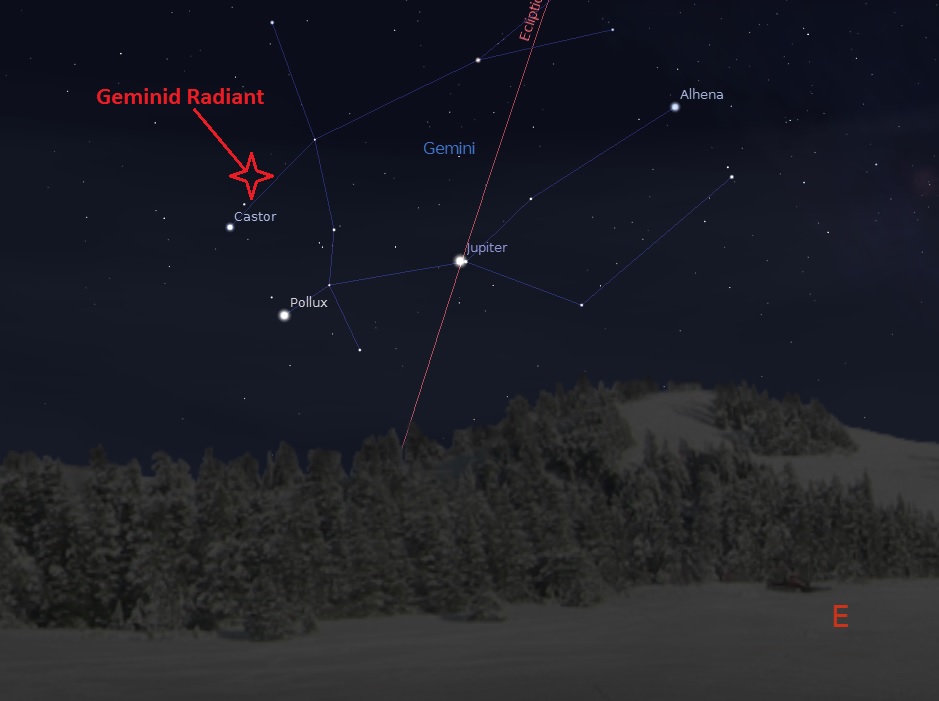December 11, 2013 5:05 pm
Saving the best for last? Watch the Geminids this Friday night!

Courtesy of Sky and Telescope: This photo shows Geminids streaming away from the shower’s radiant near the star Castor. It was made by combining 83 out of 1,256 exposures shot over an 11-hour time span on December 13-14, 2004. Image Credit: Fred Bruenjes
Could the last major meteor shower of 2013, the Geminids, be the best? We’ll find out Friday night! The Geminids peak on the night of Dec 13 thru the morning of December 14th.
There is reason to hope, in spite of the possibility of clouds and the presence of a waxing gibbous moon, three days from full.
According to Universe Today, “In the 21st century, rates for the Geminids have stayed above a ZHR (Zenithal Hourly Rate) of 120, currently the highest of any annual shower. It’s worth noting that an extrapolated ZHR of almost 200 were seen in 2011 when the Moon was at an equally unfavorable waning gibbous phase! The Geminids always produce lots of fireballs, capable of being seen even under moonlit skies.”
Also, for those of you willing to brave the early morning chill, the moon sets an hour before dawn, so that could be the absolute best time to watch the show, although the peak is projected to hit at 1:00 AM ET Saturday.
When it comes to looking up, here’s Sky and Telescope’s advice for watching the Geminids: “Bundle up as warmly as you can. Find a spot with an open view of the sky and no lights to get in your eye. Lie back in a lawn chair facing away from the Moon, gaze into the stars, and be patient. You might see a Geminid every minute or two on average depending on the brightness of your sky. The shower’s radiant point is in Gemini near Castor, and the higher that is the better, but the meteors themselves will appear anywhere in the sky. So watch wherever it’s darkest.”

Courtesy of Universe Today: The rising radiant of the Geminids-Looking east at 9PM local from latitude 30 degrees north. Image Credit: Stellarium
Sky and Telescope also says that “It becomes nicely active as early as mid-evening, so you don’t have to wait until after midnight (as is the case with many other showers). Its meteors are relatively slow, arriving at 36 km (22 miles) per second, hardly more than half the speed of the Perseids, Orionids, and Leonids.”
That slower speed leads to longer, glowing trails which are the reason I love the Geminids. There’s more to savor… and more likelihood that you actually see it, as opposed to just missing it out of the corner of your eye when you were looking a little to the left.
The Geminids are debris from 3200 Phaeton, which is a rocky object that is not a comet. In fact, according to NASA Astronomer Bill Cooke, the Geminids “defy explanation.” (For more on this mystery, check out this article on NASA Science News.) They get their name because when you follow their trails backwards, they all meet up within the constellation of Gemini.
By the way, you don’t need to wait for Friday night – Universe Today reports that people have already seen a few early Geminids last weekend.
That’s it for now. Keep Looking Up!
–Jeffrey Simons
Get the most out of StarTalk!
Ad-Free Audio Downloads
Priority Cosmic Queries
Patreon Exclusive AMAs
Signed Books from Neil
Live Streams with Neil
Learn the Meaning of Life
...and much more

 Become a Patron
Become a Patron

